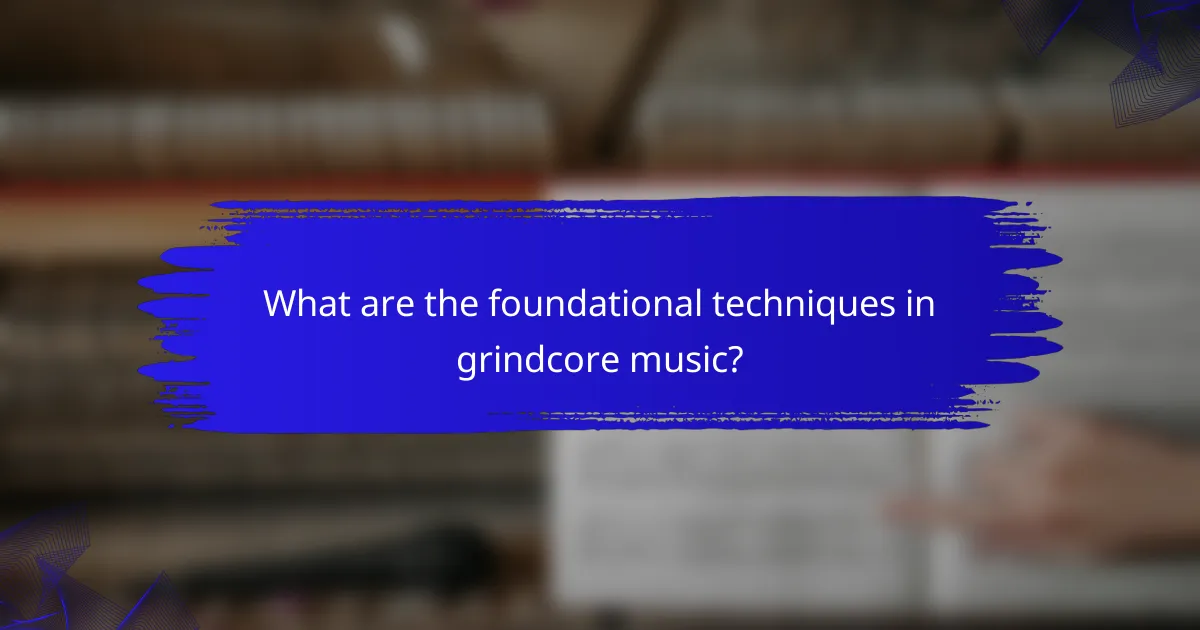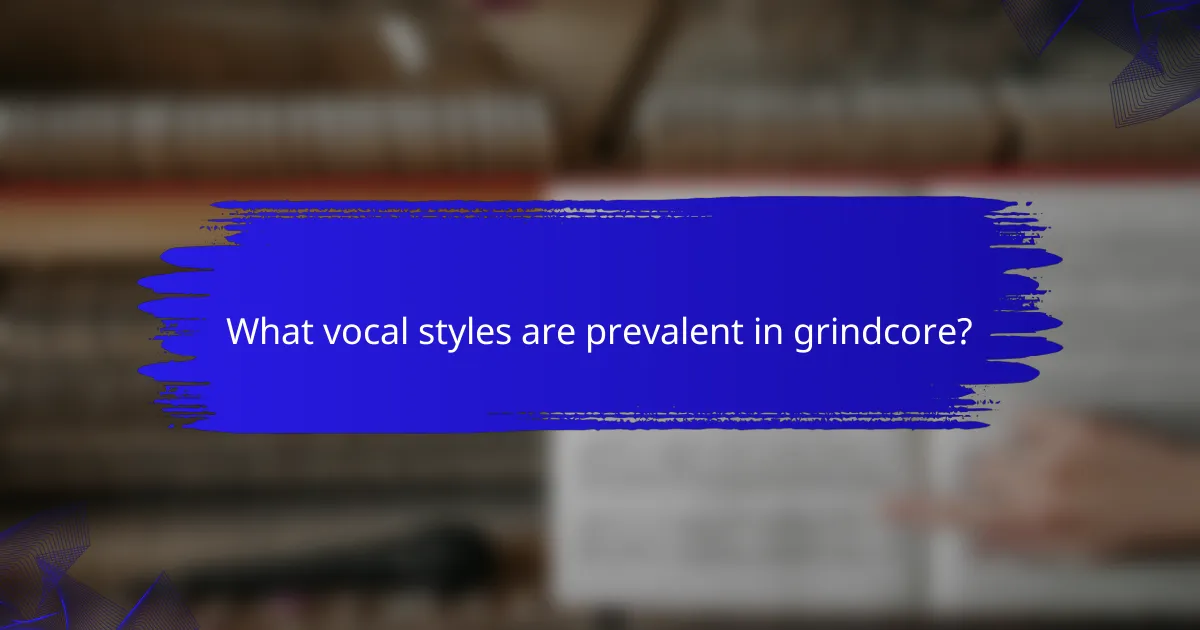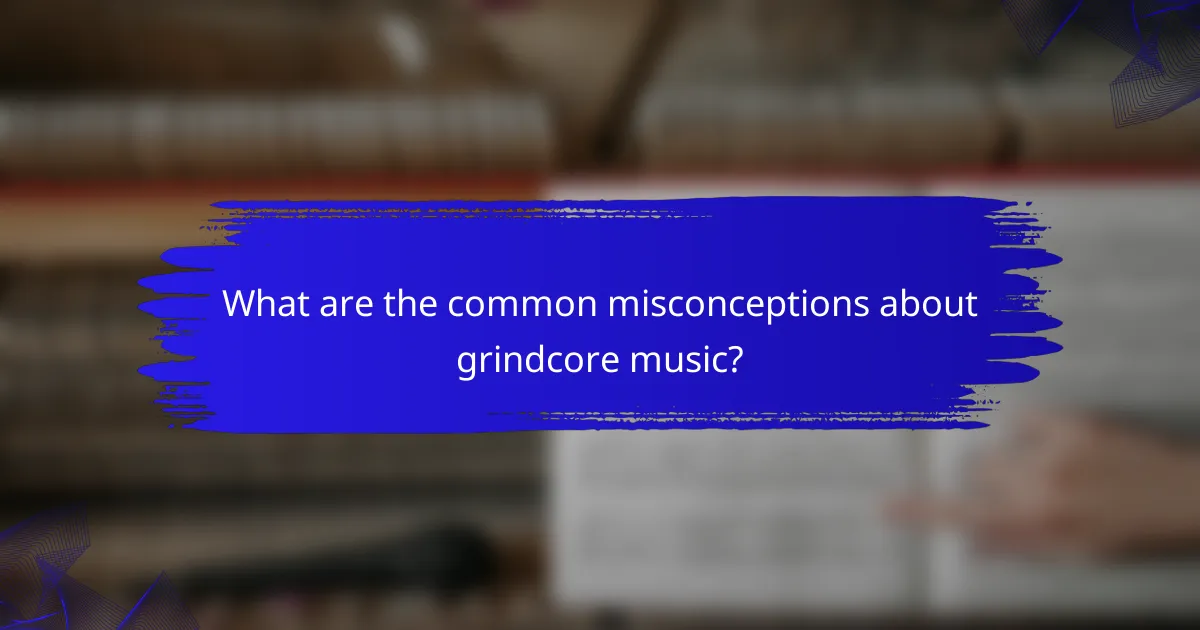Grindcore offers a unique auditory experience characterized by extreme tempos and aggressive vocal styles. This article explores essential techniques, diverse vocal expressions, and the impact of pioneering bands like Napalm Death and Brutal Truth. It also examines cultural variations and common misconceptions surrounding the genre, providing insights for aspiring musicians.

What are the foundational techniques in grindcore music?
Grindcore music relies on foundational techniques such as extreme tempos, blast beats, and heavy guitar distortion. Vocal styles include growling, screaming, and high-pitched shrieks, contributing to the genre’s intensity. Pioneering bands like Napalm Death and Brutal Truth exemplify these techniques, shaping the sound and approach of grindcore. These elements combine to create a unique auditory experience characterized by aggression and speed.
How do tempo and rhythm influence grindcore sound?
Tempo and rhythm significantly shape grindcore sound by creating intensity and urgency. Fast tempos, often exceeding 300 beats per minute, contribute to the genre’s aggressive nature. Rhythmic variations, such as blast beats, enhance the chaotic feel and dynamic structure. Pioneering bands like Napalm Death and Pig Destroyer utilize these elements to establish a distinctive auditory experience. This interplay of tempo and rhythm is crucial for conveying the emotional weight and thematic depth inherent in grindcore music.
What role does distortion play in grindcore instrumentation?
Distortion is essential in grindcore instrumentation, enhancing aggression and intensity. It shapes the guitar sound, creating a raw, abrasive texture that defines the genre. Distortion allows for a fuller sonic experience, blending with high-speed drumming and guttural vocals. This combination is crucial for achieving the chaotic energy characteristic of grindcore music.
Which techniques are unique to grindcore guitar playing?
Grindcore guitar playing features unique techniques such as blast beats, down-tuned riffs, and dissonant chord progressions. These elements create an intense sound characterized by speed and aggression. The use of palm muting and intricate picking patterns further distinguishes grindcore from other genres. Additionally, the incorporation of feedback and noise elements enhances the overall auditory experience.
How do drumming styles differ across grindcore subgenres?
Drumming styles in grindcore subgenres vary significantly in tempo, complexity, and techniques. Each subgenre emphasizes distinct rhythmic patterns and intensity levels.
For example, in fastcore, drummers often utilize rapid blast beats, while in powerviolence, the focus shifts to dynamic tempo changes and aggressive fills. Additionally, deathgrind incorporates intricate double bass patterns, contrasting with the straightforward approach of traditional grindcore.
These variations reflect the unique attributes of each subgenre, shaping the overall sound and energy of the music. Understanding these differences enhances appreciation for grindcore’s diversity and complexity.

What vocal styles are prevalent in grindcore?
Grindcore features diverse vocal styles, including high-pitched shrieks, guttural growls, and spoken word elements. These techniques contribute to the genre’s intensity and aggression. High-pitched shrieks often mimic the sound of a chainsaw, while guttural growls provide a deep, menacing tone. Additionally, some bands incorporate pig squeals and harsh whispers for variety. Pioneering bands like Napalm Death and Brutal Truth have significantly influenced these vocal approaches, establishing a foundation for modern grindcore.
How do growling and screaming techniques vary in execution?
Growling and screaming techniques differ in their vocal execution, emphasizing distinct styles and effects. Growling typically employs a lower pitch and a guttural tone, focusing on resonance from the chest. In contrast, screaming often utilizes higher pitches and a more strained vocal quality, aimed at creating a piercing sound.
The mechanics of each technique vary as well. Growling relies on vocal fry and controlled airflow, while screaming demands precise vocal cord tension and breath support. The emotional expression also varies; growling conveys heaviness and aggression, whereas screaming often communicates urgency and intensity.
Pioneering bands have influenced these techniques significantly. For instance, bands like Napalm Death popularized growling, while others like Dillinger Escape Plan showcased innovative screaming methods. Understanding these variations enriches the appreciation of grindcore’s vocal styles.
What are the emotional impacts of different vocal styles in grindcore?
Different vocal styles in grindcore evoke distinct emotional responses. High-pitched screams often convey urgency and chaos, while deep growls create a sense of dread and heaviness. These contrasts influence listener engagement, shaping the overall atmosphere of the music. Pioneering bands like Napalm Death and Pig Destroyer demonstrate this emotional range through varied vocal techniques, enhancing the genre’s intensity and impact.
Which bands are known for pioneering vocal techniques in grindcore?
Several bands are known for pioneering vocal techniques in grindcore, including Napalm Death, Carcass, and Pig Destroyer. Napalm Death introduced the iconic blast beat style and varied vocal styles, influencing countless bands. Carcass is recognized for their guttural growls and melodic elements, while Pig Destroyer is noted for their intense, high-pitched screams and innovative vocal delivery. These bands have shaped the genre’s vocal landscape significantly.

Which bands are considered pioneers of grindcore?
Pioneering bands of grindcore include Napalm Death, Carcass, and Brutal Truth. These bands shaped the genre with their aggressive sound and innovative techniques. Napalm Death, often credited as the originators, introduced fast tempos and socially conscious lyrics. Carcass contributed with their unique blend of grindcore and melodic elements, while Brutal Truth pushed boundaries by incorporating experimental sounds. Their influence remains significant in the evolution of extreme music.
What impact did Napalm Death have on the grindcore scene?
Napalm Death significantly influenced the grindcore scene by pioneering aggressive techniques and diverse vocal styles. Their fast tempos and heavy distortion set new standards, inspiring countless bands. Unique attributes like their socio-political lyrics and innovative song structures distinguished them. As a result, they became a foundational band, shaping the genre’s evolution and expanding its audience.
How did Carcass influence grindcore’s evolution?
Carcass significantly shaped grindcore’s evolution through their innovative techniques, vocal styles, and influential sound. Their use of complex song structures and melodic elements distinguished them from other bands. They introduced a unique blend of death metal and hardcore punk, setting a precedent for future grindcore bands. Their lyrical themes, often exploring societal issues and grotesque imagery, also influenced the genre’s direction. Carcass’s pioneering albums, such as “Reek of Putrefaction,” laid the groundwork for the grindcore movement, inspiring countless musicians and bands to adopt their style.
What are the contributions of regional bands to the grindcore movement?
Regional bands significantly shaped the grindcore movement by introducing diverse influences and techniques. They contributed unique vocal styles, instrumentation, and lyrical themes that expanded the genre’s boundaries. Bands like Napalm Death and Pig Destroyer showcased varying tempos and aggressive rhythms, while regional scenes fostered local talent and innovation. The grassroots nature of these bands promoted collaboration and experimentation, leading to a richer, more varied sound in grindcore. Their dedication to DIY ethics and underground culture further solidified grindcore’s identity as a rebellious and authentic music genre.

How does grindcore differ across various cultural contexts?
Grindcore varies significantly across cultural contexts, influenced by local music scenes and traditions. In the United States, grindcore often emphasizes aggressive instrumentation and politically charged lyrics, exemplified by bands like Napalm Death. In contrast, Japanese grindcore incorporates unique sound elements, blending noise and experimental influences, as seen in bands like Gore Beyond Necropsy. European grindcore frequently showcases a mix of melodic elements and complex song structures, with bands like Rotten Sound leading the charge. These cultural distinctions highlight how grindcore adapts and evolves, reflecting regional attitudes and musical heritage.
What are the unique attributes of grindcore in North America?
Grindcore in North America is characterized by its aggressive techniques, diverse vocal styles, and influential pioneering bands. Unique attributes include the fusion of extreme metal and punk, rapid tempo changes, and unconventional song structures. Notable bands like Napalm Death and Pig Destroyer have shaped its identity, contributing to its distinct sound and cultural impact. The genre also features a blend of lyrical themes that often critique societal issues, setting it apart from other music styles.
How does grindcore in Europe reflect local influences?
Grindcore in Europe reflects local influences through diverse techniques, vocal styles, and pioneering bands. Each region contributes unique elements, shaped by cultural and musical backgrounds. For instance, British grindcore often incorporates punk influences, while Scandinavian bands may blend death metal characteristics. This fusion creates a rich sound palette that resonates with local audiences, showcasing distinctive attributes like tempo variations and lyrical themes. Pioneering bands such as Napalm Death and Carcass have played crucial roles, influencing the genre’s evolution and regional adaptations.
What role does grindcore play in underground music scenes globally?
Grindcore plays a significant role in underground music scenes globally by promoting extreme musical expression and subverting mainstream norms. This genre combines elements of hardcore punk and extreme metal, characterized by fast tempos, blast beats, and aggressive vocal styles. Pioneering bands like Napalm Death and Carcass have influenced countless artists and fostered a sense of community among fans. The unique attribute of grindcore lies in its ability to address social and political issues through its intense sound and lyrical content, making it a powerful voice within underground movements.

What are the common misconceptions about grindcore music?
Grindcore music is often misunderstood, leading to several misconceptions. Many believe it lacks musicality, but it combines complex rhythms and structures. Others think it’s solely about speed; however, emotional depth and lyrical content are significant. Some assume all grindcore is violent, while it can also convey social and political messages. Lastly, many overlook its diverse vocal styles, which include growls, screams, and clean singing, showcasing its versatility.
How does grindcore challenge mainstream music norms?
Grindcore challenges mainstream music norms through its extreme speed, aggressive vocals, and unconventional song structures. This genre often features blast beats, guttural screams, and abrupt tempo changes, creating a stark contrast to typical pop and rock formats. Pioneering bands like Napalm Death and Carcass exemplify these techniques, pushing boundaries with their raw sound and lyrical themes. As a result, grindcore not only defies musical conventions but also fosters a unique subculture that values authenticity and artistic expression.
What are the stereotypes associated with grindcore fans?
Grindcore fans often face stereotypes of being aggressive, antisocial, and elitist. These perceptions stem from the genre’s intense sound and confrontational themes. Many believe that grindcore fans reject mainstream music and embrace a DIY ethos. Additionally, fans are sometimes viewed as overly critical of other genres, which reinforces the stereotype of exclusivity.

What best practices should aspiring grindcore musicians follow?
Aspiring grindcore musicians should focus on mastering speed, aggression, and unique vocal techniques. Key practices include developing precise drumming skills, experimenting with unconventional song structures, and incorporating diverse influences. Pioneering bands like Napalm Death and Pig Destroyer offer valuable insights into innovative approaches and styles. Engaging with the grindcore community through live shows and online platforms can also enhance growth and collaboration.
How can musicians effectively collaborate in grindcore projects?
Musicians can effectively collaborate in grindcore projects by emphasizing communication, shared vision, and adaptability. Establishing clear roles within the group fosters creativity and ensures everyone contributes their unique strengths. Regular practice sessions enhance cohesion and allow for experimentation with diverse vocal styles and techniques. Pioneering bands often showcase the importance of blending influences, which can lead to innovative soundscapes. Embracing feedback and being open to change are crucial for refining the collaborative process.
What common mistakes should be avoided in grindcore songwriting?
Avoiding common mistakes in grindcore songwriting enhances creativity and effectiveness. Key errors include overcomplicating structures, neglecting dynamics, and imitating rather than innovating.
1. Overly Complex Arrangements: Simplifying song structures can enhance clarity and impact.
2. Lack of Variation: Incorporating dynamics and tempo changes keeps the listener engaged.
3. Generic Lyrics: Crafting original, meaningful lyrics distinguishes the work from others.
4. Ignoring Instrumental Balance: Ensuring all instruments are heard creates a cohesive sound.
5. Failing to Experiment: Embracing unique sounds and techniques fosters originality.
How can musicians innovate within the grindcore genre?
Musicians can innovate within the grindcore genre by experimenting with unconventional techniques, vocal styles, and influences from other genres. One approach is incorporating diverse instrumentation, such as jazz or electronic elements, to create unique soundscapes.
Vocal styles can also evolve; for instance, blending traditional growls with melodic elements or spoken word can introduce fresh dynamics. Pioneering bands like Napalm Death and Pig Destroyer have set precedents by pushing boundaries, encouraging musicians to explore new lyrical themes and song structures.
Additionally, incorporating technology, such as digital production techniques, allows for innovative sound manipulation. This fusion of creativity and tradition can lead to a revitalized grindcore experience that resonates with both old and new audiences.